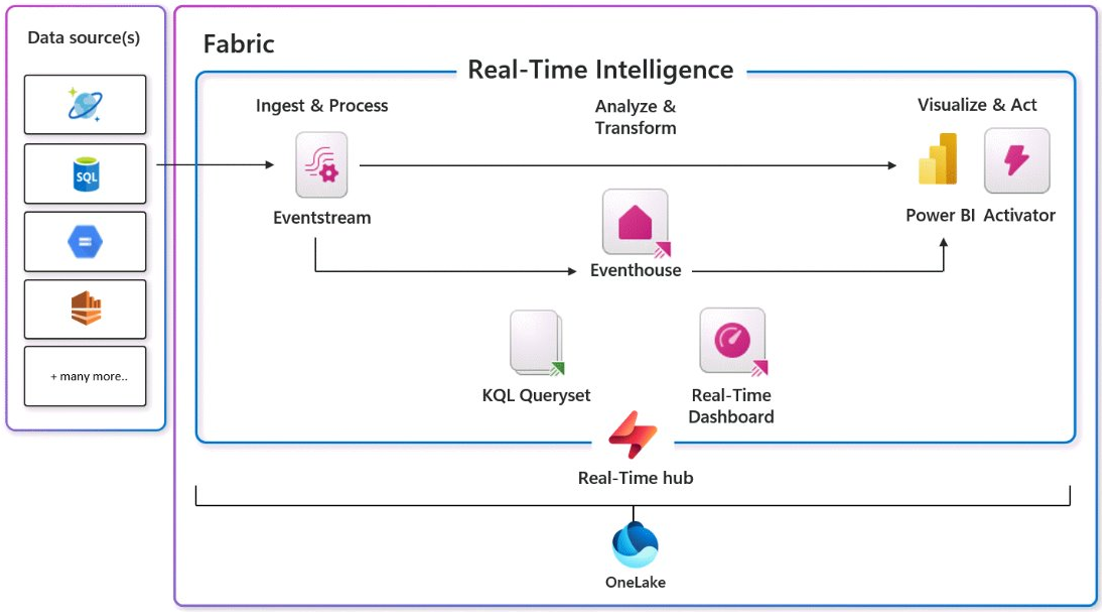October 29, 2025 - by Hiren Kapadia
For years, real-time intelligence has been the holy grail of data-driven decision-making — powerful in theory but costly and complex in practice. However, with Microsoft Fabric, that changes. What was once out of reach is now practical, scalable, and within every organization’s grasp. With Fabric, organizations can unify streaming data from applications, IoT devices, sensors, and logs into a single platform, where it can be ingested, transformed, visualized, and acted upon in real-time.
Whether you’re evaluating Microsoft Fabric services or seeking a Microsoft Fabric partner to deploy them, consider this your roadmap to unlocking real-time intelligence.
How Microsoft Fabric Powers Real-time Intelligence
To truly understand the value of real-time intelligence in Microsoft Fabric, it helps to see how the pieces fit together. Fabric brings ingestion, transformation, analysis, visualization, and action into one seamless flow, so organizations can move from raw data in motion to real-time decisions without complex integrations. The diagram below shows how Fabric unifies these capabilities into a single, end-to-end platform.

Event Hubs: Where Data Starts
The pipeline begins with ingestion. Azure Event Hubs delivers high-throughput, low-latency event processing from external systems, applications, sensors, logs, APIs, and more. Inside Microsoft Fabric, Eventstreams lets you wire up those feeds and shape the data as it moves. You filter it, rename fields, convert formats, and route it to multiple destinations. No code is required.
Whether you’re managing clickstream data, IoT telemetry, or transaction logs, this is where your real-time architecture comes to life.
A Microsoft Fabric Consulting team can help you securely and efficiently connect your enterprise systems to these streams, especially when data volume, governance, and compliance are involved.
Eventhouse and KQL: Query at the Speed of Thought
Once events are received, they are stored in Eventhouse, a purpose-built repository for time-series and event-driven data. Under the hood, it runs on KQL databases and is optimized for speed and scale. That means fast scans, indexed queries, real-time filters, and analytical joins across millions of records.
KQL (Kusto Query Language) isn’t just for experts anymore. With a slight learning curve, anyone on your analytics team can write useful queries to track anomalies, calculate trends, or set thresholds —all live and on demand.
A Microsoft Fabric partner can add significant value in this area. They can model your telemetry data, define custom retention policies, and optimize the structure to support fast, low-cost queries.
Real-Time Hub: The Operational Control Center
The real-time hub within Fabric provides visibility across every pipeline. It shows what data is being received, how it’s flowing, which tables are being updated, and what actions are being triggered.
You can trigger alerts, reroute sources, inspect failed events, or tune filters without leaving the hub. This eliminates guesswork and provides operations and analytics teams with a shared, reliable source of truth.
Live Dashboards: Know What’s Happening, As It Happens
This is where it all comes together. Real-time dashboards in Fabric aren’t static reports or delayed refreshes. Every tile can connect to live queries or streams. If a system goes down, a sensor fails, or traffic spikes, your dashboard changes immediately—not minutes later, not after a batch job, but now.
This is especially powerful for industries where real-time data can drive real-world outcomes, such as logistics, manufacturing, finance, retail, and healthcare.
A Microsoft Fabric Consulting team can help design not just visually appealing but also purposeful dashboards. They can be built around your KPIs, connected to your triggers, and tuned for your workflows.
Activator: Turning Data into Decisions
Insight alone isn’t enough. That’s why Fabric includes Activator, a tool that monitors your dashboards or event streams for triggers and then takes action.
It can send alerts, launch workflows, fire off an Azure Function, create tickets, or send data back into other systems.
This allows teams to respond without needing to constantly monitor screens. Set the rules once and let the system do the watching.
What Microsoft Fabric Makes Possible
With Microsoft Fabric, real-time analytics goes beyond speed – it drives measurable business outcomes. By transforming constant data streams into timely, intelligent actions, Fabric empowers organizations to address challenges that were once too complex or too costly to resolve.
From ingestion and processing to live dashboards and automated actions, Fabric brings every stage of the real-time data journey into a single, scalable platform.
Microsoft Fabric supports some severe real-time use cases:
- A retailer adjusting pricing or inventory allocation based on live demand.
- A logistics company rerouting deliveries based on weather or traffic.
- A bank detecting fraud patterns across accounts before fraud happens.
- A healthcare system monitoring patient vitals and alerting caregivers instantly.
Case Study: Real-time Intelligence using Microsoft Fabric
A global manufacturing enterprise with over 80 production plants worldwide sought to modernize its data infrastructure to enable real-time operational insights and faster decision-making. Each plant operated with around 1,000 IoT sensors collecting critical metrics such as temperature, vibration, energy usage, and equipment status. While vast amounts of telemetry data were generated, the client lacked a unified platform to ingest, process, and analyze it across the global landscape, leading to data silos and operational inefficiencies.
To address this, Synoptek implemented a comprehensive solution leveraging Microsoft Fabric. The architecture included Azure Event Hub for real-time data ingestion and streaming, as well as the integration of Microsoft Fabric Event Streams for analytics in KQL databases. SAP APIs were connected for supply chain synchronization, and Power BI dashboards were deployed for live factory visibility. The solution enabled flexible KQL-based self-service analytics and supported future AI/ML scalability, ensuring data centralization and consistent processing across all global plants.
The impact was significant. The new platform centralized daily gigabytes of sensor data, previously isolated within individual plants, into a unified system. It delivered real-time dashboards that provided critical insights into equipment health, production bottlenecks, safety compliance, and sensor anomalies. This transformation enhanced operational efficiency and transparency, reduced manual interventions, and laid the groundwork for predictive analytics across the enterprise.
Choosing the Right Microsoft Fabric Partner
Working with a qualified Microsoft Fabric partner can help drive the best results. While the tools are powerful, their real value lies in tailoring them to your specific environment. A partner can help:
- Integrate Fabric with your existing Azure ecosystem
- Model your event data and storage for optimal cost and performance
- Set up governance, compliance, and access control
- Build dashboards that align with how your teams actually work
- Deploy workflows that turn analytics into action
Turn Real-time Data into Real-world Advantage
Real-time analytics once seemed out of reach. Today, it’s not only possible but practical, scalable, and built on the Microsoft tools you already trust. With the right architecture, clean data, and a strategic implementation, Microsoft Fabric lets you move from insight to action without delay.
Ready to turn real-time data into real-world advantage? Let Synoptek’s Microsoft Fabric Services experts show you what’s possible. Contact us
Frequently Asked Questions
1. What is Microsoft Fabric Consulting?
Microsoft Fabric Consulting helps organizations design and implement real-time analytics solutions tailored to their business needs.
2. How does Microsoft Fabric simplify real-time analytics?
Microsoft Fabric unifies data ingestion, querying, visualization, and automation into a single, seamless, and scalable platform.
3. How do Microsoft Fabric Services enhance data operations?
Microsoft Fabric Services unify data ingestion, querying, dashboards, and automation—simplifying real-time analytics across the enterprise.
4. Why should businesses work with a Microsoft Fabric Partner?
A Microsoft Fabric Partner provides expert guidance, seamless integration, and optimized performance for your analytics environment.
5. How can Microsoft Fabric Consulting improve operational efficiency?
By enabling live dashboards and automated insights, Microsoft Fabric Consulting helps teams act faster on real-time data.
About the Author
Hiren Kapadia is Director – Business Intelligence at Synoptek, with two decades of extensive experience in the Software Development Life Cycle (SDLC). Throughout this journey, Hiren has been deeply involved in numerous Data Warehousing and ETL projects, utilizing a spectrum of technologies including various database platforms, MSBI, Data Factory, Pentaho, QlikView, Power BI, Tableau, and Azure cloud-based solutions. His core responsibilities encompass many pivotal tasks such as database modeling and design, metadata management, database coding, establishing data warehouses, and crafting insightful visualizations.

